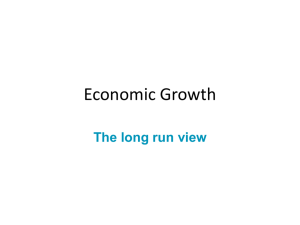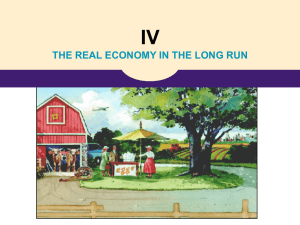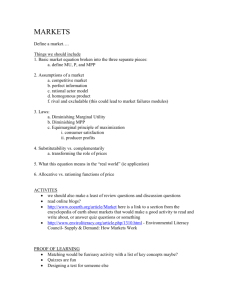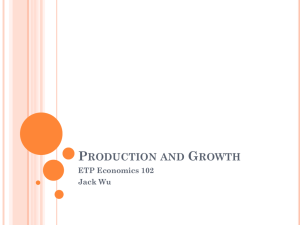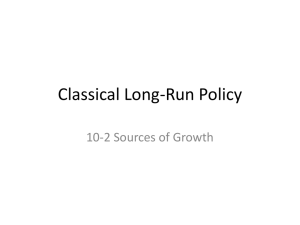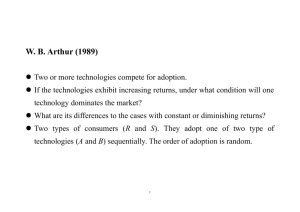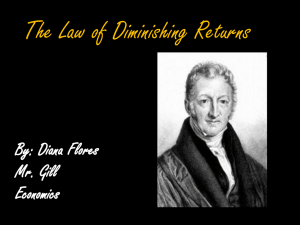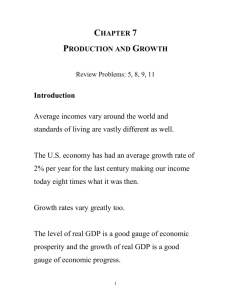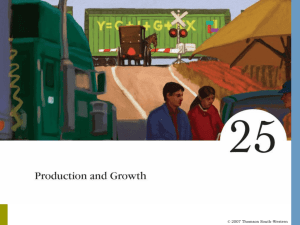Production and Growth
advertisement
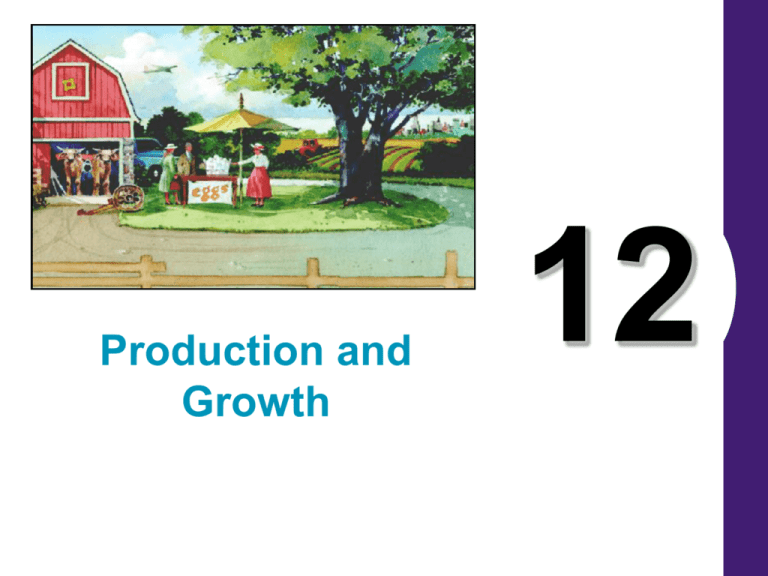
Production and Growth 12 Production and Growth • A country’s standard of living depends on its ability to produce goods and services. Production and Growth • Productivity refers to the amount of goods and services produced for each hour of a worker’s time. • A nation’s standard of living is determined by the productivity of its workers. Table 1 The Variety of Growth Experiences ECONOMIC GROWTH AROUND THE WORLD • Annual growth rates that seem small become large when compounded for many years. • Compounding refers to the accumulation of a growth rate over a period of time. Why Productivity Is So Important • Productivity refers to the amount of goods and services that a worker can produce from each hour of work. • Productivity plays a key role in determining living standards for all nations in the world. How Productivity Is Determined • The inputs used to produce goods and services are called the factors of production. • The factors of production directly determine productivity. How Productivity Is Determined • The Factors of Production • • • • Physical capital Human capital Natural resources Technological knowledge How Productivity Is Determined • Physical Capital • is a produced factor of production. • It is an input into the production process that in the past was an output from the production process. • is the stock of equipment and structures that are used to produce goods and services. • Tools, machinery. • Office buildings, factories, schools, etc. How Productivity Is Determined • Human Capital • the knowledge and skills that workers acquire through education, training, and experience • Like physical capital, human capital raises a nation’s ability to produce goods and services. How Productivity Is Determined • Natural Resources • inputs used in production that are provided by nature, such as land, rivers, and mineral deposits. • Renewable resources include trees and forests. • Nonrenewable resources include petroleum and coal. • Technology • society’s understanding of the best ways to produce goods and services. FYI: The Production Function • Economists often use a production function to describe the relationship between the quantity of inputs used in production and the quantity of output from production. FYI: The Production Function • Y = α F(L, K, H, N) • • • • • • • Y = quantity of output A = available production technology L = quantity of labor K = quantity of physical capital H = quantity of human capital N = quantity of natural resources F( ) is a function that shows how the inputs are combined. FYI: The Production Function • A production function has constant returns to scale if, for any positive number x, xY = F(xL, xK, xH, xN) • That is, a doubling of all inputs causes the amount of output to double as well. ECONOMIC GROWTH AND PUBLIC POLICY • Government Policies That Raise Productivity and Living Standards • • • • Encourage saving and investment. Encourage investment from abroad Encourage education and training. Establish secure property rights and maintain political stability. • Promote free trade. • Promote research and development. The Importance of Saving and Investment • One way to raise future productivity is to invest more current resources in the production of capital. • Firms create physical capital through investment. • Investment is often done on borrowed funds, and the role of the financial system is to move the funds from savers to borrowers. Figure 1 Growth and Investment (b) Investment 1960–1991 (a) Growth Rate 1960–1991 South Korea Singapore Japan Israel Canada Brazil West Germany Mexico United Kingdom Nigeria United States India Bangladesh Chile Rwanda 0 South Korea Singapore Japan Israel Canada Brazil West Germany Mexico United Kingdom Nigeria United States India Bangladesh Chile Rwanda 1 2 3 4 5 6 7 Growth Rate (percent) 0 10 20 30 40 Investment (percent of GDP) Diminishing Returns and the Catch-Up Effect • As the stock of capital rises, the extra output produced from an additional unit of capital falls; this property is called diminishing returns. • Because of diminishing returns, the effect of additional saving and investment on growth is ultimately limited. Diminishing Returns and the Catch-Up Effect • The catch-up effect refers to the property whereby countries that start off poor tend to grow more rapidly than countries that start off rich. Investment from Abroad • Governments can increase capital accumulation and long-term economic growth by encouraging investment from foreign sources. • Investment from abroad takes several forms: • Foreign Direct Investment • Capital investment owned and operated by a foreign entity. • Foreign Portfolio Investment • Investments financed with foreign money but operated by domestic residents. Education • An educated person might generate new ideas about how best to produce goods and services, which in turn, might enter society’s pool of knowledge and provide an external benefit to others. Education • One problem facing some poor countries is the brain drain—the emigration of many of the most highly educated workers to rich countries. Property Rights and Political Stability • Property rights refer to the ability of people to exercise authority over the resources they own. • An economy-wide respect for property rights is an important prerequisite for the price system to work. • It is necessary for investors to feel that their investments are secure. Free Trade • Some countries engage in . . . • . . . inward-orientated trade policies, avoiding interaction with other countries. • . . . outward-orientated trade policies, encouraging interaction with other countries. Research and Development • The advance of technological knowledge has led to higher standards of living. • Much of technological advance comes from private research by firms and individual inventors. • Government can encourage the development of new technologies through research grants, tax breaks, and the patent system. Figure 2 The Growth in Real GDP Per Person Growth Rate (percent per year) 4.0 3.5 3.0 2.5 2.0 1.5 1.0 0 1870– 1890– 1910– 1930– 1950– 1970– 1890 1910 1930 1950 1970 1990 1990– 2000 Summary • Economic prosperity, as measured by real GDP per person, varies substantially around the world. • The average income of the world’s richest countries is more than ten times that in the world’s poorest countries. • The standard of living in an economy depends on the economy’s ability to produce goods and services. Summary • Productivity depends on the amounts of physical capital, human capital, natural resources, and technological knowledge available to workers. • The accumulation of capital is subject to diminishing returns. • Because of diminishing returns, higher saving leads to a higher growth for a period of time, but growth will eventually slow down.
